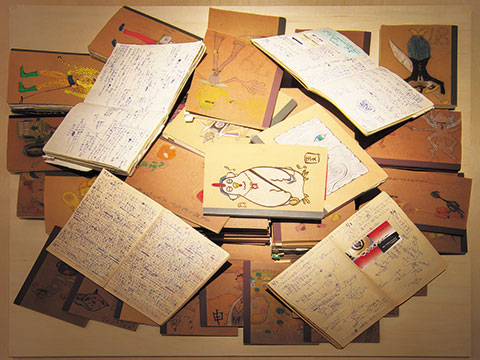ごあいさつ
白川裕信 ギャラリーエークワッド 館長

ギャラリーエークワッドは2005年に開設され、今年で13年目を迎え、本展は記念すべき100回目の企画展になります。開設当初から木下先生にはご指導をいただいており、特に「100人の東京駅」に始まる一般公募者100人による撮影会は、先生のフィールドワークのご経験を活かした企画として始まっています。
先生は2000年に東京大学大学院に設立された文化資源学研究室に招かれ、20年近くにわたり「近代の日本美術」に軸足を置きつつ、美術に隣接する領域へと関心を広げてこられました。本企画は、これまでに書かれた12冊の本を全集に見立て、「木下直之を全ぶ集める」と銘打った展覧会で、膨大な業績を包括的に俯瞰できる内容になっています。
Web上でもヴァーチャルな展覧会を1年前からギャラリーのホームページ上でオープンしています。
先生の論説は、日常身の回りにあって、何気なく見過ごしているモノ、コトに対して問題意識を持たれ、綿密な調査による裏付けの上に独自の解釈を加え、文脈を仕立て直し、文化的価値を発掘されています。ここに至る過程では、問題は増殖を繰り返し、新たな疑問や課題に突き当たり、さらなる思索の果てに深層を手繰り寄せ、成果として定着させてこられたように思います。12冊の著書の背後にほぼ120冊のノートがあり、更にその背後にファイルがあるそうで、それが系統化された手書きの樹形図をご覧ください。これを見るだけでも価値があると思います。ハッとする本のタイトルや章立ての言葉は長い思考の果てにあったのだということがわかります。と同時に、その痕跡は芸術作品のようにも見えてきませんか?
見世物小屋を覗いてみて下さい。展覧会場に並ぶコンテンツの一つ一つに木下直之の心血が注がれています。近くても遠い場所へ皆様をお連れします。
展覧会の開催にあたり、貴重な資料等のご提供、ご協力いただきました関係機関、関係者の皆様に対しまして、心より感謝の意を表します。
Opening remarks
Shirakawa Hironobu Director, Gallery A4

Gallery A4, having opened in 2005, is now in its 13th year, and this exhibition marks the 100th special exhibition to be held at this gallery. From the beginning, Professor Kinoshita has been an invaluable advisor to us, particularly for exhibitions such as “100 People’s Tokyo Station,” a project that made use of Mr. Kinoshita’s extensive fieldwork experience, using photos taken by 100 people recruited from the general public.
In the nearly 20 years that have passed since he was invited to the Office of Cultural Resources Studies, a research center established in 2000 at the University of Tokyo graduate school, Kinoshita has expanded his range of interests to art-related domains while maintaining a focus on modern Japanese art. “Collecting All of Naoyuki Kinoshita,” an exhibition that likens the 12 books he has written to a set of “complete works,” gives us a comprehensive, bird’s eye view of his enormous achievements.
A virtual exhibition that opened one year ago is also available for viewing on the Gallery A4 website.
Kinoshita’s writings unearth the cultural value that is hidden in everyday, often-overlooked objects and occurrences, to which he brings a critical awareness and adds a unique interpretation supported by careful investigation, providing us with a new perceptual context. He has achieved this, it seems, through a process in which problems present themselves again and again, and new issues and questions constantly emerge, requiring further thought to get at the deepest levels. Behind his 12 books are nearly 120 notebooks, and apparently there are also numerous files behind these notebooks as well. You can see all of this presented systematically in a handwritten tree diagram. This diagram alone is well worth a view, and shows that a great deal of thought went into his pithy book titles and chapter headings. It also strikes me as a work of art in itself.
Please have a look at the show booths. Each and every item that is on display at this exhibition contains the heart and soul of Naoyuki Kinoshita. They will take you to a place that is near, yet far away.
I would like to express my heartfelt gratitude to the people and institutions who helped make this exhibition possible through their cooperation and generosity in providing valuable resources.